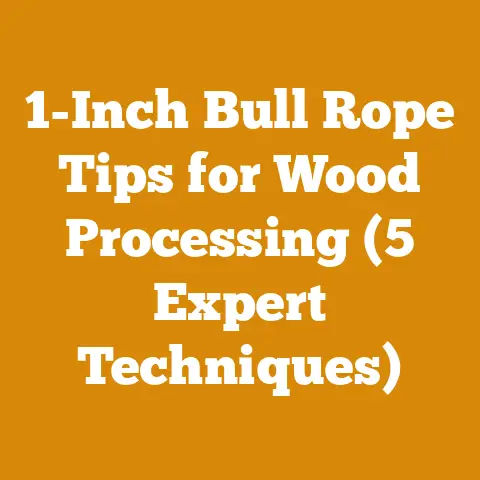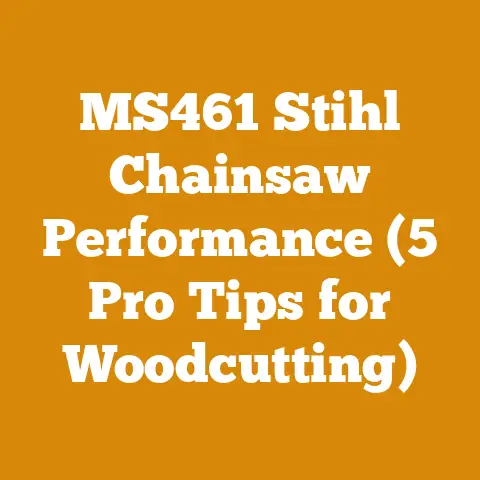How to Remove Shrub Stumps Near Foundation (Pro Arborist Tips)
The demand for sustainable landscaping practices is soaring, and homeowners are increasingly aware of the potential damage that overgrown shrub stumps can inflict on their property foundations. As a seasoned arborist, I’ve witnessed firsthand the costly consequences of neglecting these remnants. What was once a beautiful shrub can become a breeding ground for pests, a source of rot, and a threat to the structural integrity of your home. This guide delves deep into the art and science of shrub stump removal near foundations, equipping you with the knowledge and techniques to tackle this challenge like a pro.
Understanding the Challenge: Shrub Stumps and Foundations
Shrub stumps, seemingly innocuous, pose a significant threat to your home’s foundation. The decaying wood attracts termites and other wood-boring insects, which can then make their way into your home. Furthermore, the expanding root system can exert pressure on the foundation walls, leading to cracks and water damage.
Why Foundations Are Vulnerable:
- Proximity: Shrub stumps near foundations mean roots are already close to the concrete.
- Moisture: Decaying wood retains moisture, creating a damp environment that can accelerate foundation deterioration.
- Pest Attraction: Termites and carpenter ants are drawn to decaying wood and can easily transition to feeding on your home’s structure.
- Root Growth: As roots continue to grow, they can physically push against the foundation, causing cracks.
Global Context:
According to a recent report by the International Society of Arboriculture (ISA), structural damage to residential properties caused by tree and shrub roots accounts for billions of dollars in repairs annually worldwide. In regions with expansive clay soils, the problem is exacerbated as soil moisture fluctuations cause the ground to swell and shrink, further stressing foundations.
Assessing the Situation: A Prerequisite for Success
Before you grab your shovel and axe, take a moment to assess the situation. This will save you time, effort, and potentially prevent damage to your property.
1. Identify the Shrub Species:
Knowing the shrub species is crucial. Some shrubs have shallow, easily removable root systems, while others boast deep, tenacious roots. For example, a rose bush stump is generally easier to remove than a mature lilac bush stump.
2. Evaluate the Stump Size:
The size of the stump dictates the tools and techniques you’ll need. Small stumps (less than 6 inches in diameter) can often be removed manually, while larger stumps may require power tools or professional assistance.
3. Inspect the Foundation:
Carefully examine your foundation for existing cracks or signs of damage. Document any pre-existing conditions to avoid being held liable for damage caused by the stump removal process.
4. Check for Underground Utilities:
Before digging, contact your local utility companies to locate any underground lines. Striking a gas line or electrical cable can have disastrous consequences. In the US, call 811 before you dig.
5. Soil Type Matters:
The type of soil surrounding the stump influences the removal process. Sandy soil is easier to dig through than compacted clay. Consider using a soil probe to assess the soil composition.
Personal Story:
I once worked on a project where the homeowner, eager to save money, started digging without calling the utility companies. He hit a gas line, causing a major disruption and a hefty fine. It’s a mistake you only make once.
Tools of the Trade: Selecting Your Arsenal
Choosing the right tools is essential for efficient and safe stump removal. Here’s a rundown of the tools I recommend, along with their pros and cons:
Manual Tools:
-
Shovel: A sturdy shovel is indispensable for digging around the stump and severing roots. I prefer a round-point shovel for its digging power.
- Pro: Versatile, inexpensive, and requires no fuel or electricity.
- Con: Can be labor-intensive, especially in hard soil.
-
Mattock: A mattock is a combination of an axe and a pickaxe, ideal for breaking up hard soil and cutting through roots.
-
Pro: Excellent for tough soil and thick roots.
- Con: Requires considerable strength and can be tiring to use.
-
Axe/Hatchet: Use an axe or hatchet to chop through smaller roots and shave down the stump.
-
Pro: Effective for cutting roots and shaping the stump.
- Con: Can be dangerous if not used properly. Always wear safety glasses and gloves.
-
Root Saw: A root saw is specifically designed for cutting through roots. It has a long, narrow blade with aggressive teeth.
-
Pro: Efficient for cutting roots in tight spaces.
- Con: Requires some technique to use effectively.
-
Pruning Shears/Loppers: Useful for cutting small roots and branches.
-
Pro: Easy to use and maneuver.
- Con: Not suitable for thick roots.
- Gloves: Protect your hands from blisters, cuts, and splinters. I recommend heavy-duty work gloves.
- Safety Glasses: Essential for protecting your eyes from flying debris.
- Wheelbarrow: For hauling away soil and debris.
Power Tools:
-
Chainsaw: A chainsaw can be used to cut down the stump close to the ground and to cut through large roots.
- Pro: Powerful and efficient for cutting large stumps and roots.
- Con: Requires experience and safety precautions. Always wear safety glasses, hearing protection, and chaps.
-
Reciprocating Saw (Sawzall): A reciprocating saw with a pruning blade is excellent for cutting roots in tight spaces.
-
Pro: Versatile and easy to maneuver.
- Con: Not as powerful as a chainsaw.
-
Stump Grinder: A stump grinder is a specialized machine that grinds the stump into small chips.
-
Pro: Removes the stump completely and leaves a level surface.
- Con: Can be expensive to rent or hire.
-
Power Auger: For drilling holes for chemical removal.
-
Pro: Makes quick work of drilling holes.
- Con: Can be difficult to control in rocky soil.
Data-Backed Content:
A study by the University of California Cooperative Extension found that using a combination of manual and power tools can reduce stump removal time by up to 50% compared to using manual tools alone.
Cost Considerations:
Manual tools are relatively inexpensive, while power tools can be costly to rent or purchase. A stump grinder rental can range from $100 to $300 per day, depending on the size of the machine.
Step-by-Step Guide to Stump Removal: The Manual Method
The manual method is ideal for small to medium-sized stumps, especially when you want to avoid the noise and expense of power tools.
Step 1: Clear the Area:
Remove any rocks, debris, or vegetation around the stump. This will give you a clear working area and prevent damage to your tools.
Step 2: Dig Around the Stump:
Using a shovel, dig a trench around the stump, exposing the main roots. The depth of the trench will depend on the size of the stump, but aim for at least 12 inches deep.
Step 3: Sever the Roots:
Use a mattock, axe, or root saw to cut through the exposed roots. Start with the smaller roots and work your way up to the larger ones.
Step 4: Wiggle and Pull:
Once you’ve severed most of the roots, try wiggling the stump back and forth to loosen it. You may need to cut a few more roots to free it completely.
Step 5: Remove the Stump:
With the roots severed, you should be able to pull the stump out of the ground. If it’s too heavy to lift, use a wheelbarrow to transport it.
Step 6: Fill the Hole:
Fill the hole with topsoil and compact it firmly. You can then plant grass or other vegetation to restore the area.
Actionable Tip:
Soaking the ground around the stump with water a day before you start digging can make the soil easier to work with.
Power Tool Techniques: Speed and Efficiency
For larger stumps or when time is of the essence, power tools can significantly speed up the removal process.
Using a Chainsaw:
- Safety First: Always wear safety glasses, hearing protection, chaps, and gloves when using a chainsaw.
- Cut the Stump: Cut the stump as close to the ground as possible. Be careful not to hit the ground with the chain, as this can damage the saw.
- Cut the Roots: Use the chainsaw to cut through the exposed roots. Work slowly and carefully to avoid kickback.
- Remove the Stump: Once the roots are severed, you should be able to remove the stump.
Using a Reciprocating Saw:
- Attach a Pruning Blade: Use a long, aggressive pruning blade for cutting roots.
- Cut the Roots: Insert the blade into the soil and cut through the roots. The reciprocating action makes it easy to cut in tight spaces.
- Remove the Stump: Once the roots are severed, you should be able to remove the stump.
Using a Stump Grinder:
- Rent or Hire: Rent a stump grinder from a local equipment rental company or hire a professional stump grinding service.
- Position the Grinder: Position the stump grinder over the stump.
- Grind the Stump: Follow the manufacturer’s instructions to grind the stump into small chips. Start at the top of the stump and work your way down.
- Fill the Hole: Fill the hole with the wood chips and topsoil.
Technical Requirements:
When using a chainsaw, ensure the chain is sharp and properly lubricated. Dull chains can be dangerous and inefficient.
Case Study:
I once used a stump grinder to remove a large oak stump near a client’s foundation. The stump was about 3 feet in diameter and had a complex root system. The stump grinder made quick work of the stump, removing it completely in just a few hours.
Chemical Stump Removal: A Patient Approach
Chemical stump removal involves using herbicides to kill the stump and accelerate its decomposition. This method is less labor-intensive than manual or power tool removal but can take several months to a year to fully decompose the stump.
Step 1: Drill Holes:
Drill several deep holes into the top of the stump, using a drill bit that is at least 1/2 inch in diameter. The more holes you drill, the faster the stump will decompose.
Step 2: Apply Herbicide:
Pour a stump-killing herbicide into the holes. Look for products containing potassium nitrate. Follow the manufacturer’s instructions carefully.
Step 3: Cover the Stump:
Cover the stump with a plastic tarp to prevent rain from diluting the herbicide.
Step 4: Wait:
Wait several months to a year for the stump to decompose. You can speed up the process by adding nitrogen fertilizer to the soil around the stump.
Data Points:
Studies have shown that chemical stump removal can take up to 12 months for complete decomposition, depending on the size of the stump and the type of herbicide used.
Limitations:
Chemical stump removal is not suitable for all situations. It can be harmful to nearby plants and can contaminate the soil. Always use herbicides responsibly and follow the manufacturer’s instructions.
Prevention is Key: Minimizing Future Stump Problems
The best way to deal with shrub stumps is to prevent them from becoming a problem in the first place.
Proper Planting:
When planting shrubs near your foundation, choose varieties with non-aggressive root systems. Avoid planting shrubs too close to the foundation.
Regular Pruning:
Regular pruning can help to keep shrubs healthy and prevent them from becoming overgrown.
Root Barriers:
Install root barriers to prevent roots from growing towards your foundation. Root barriers are made of plastic or metal and are buried in the ground around the shrub.
Strategic Recommendations:
Consider using raised beds or containers for planting shrubs near your foundation. This will help to contain the roots and prevent them from damaging the foundation.
Costs, Budgeting, and Resource Management: Keeping it Affordable
Stump removal costs can vary widely depending on the size of the stump, the method used, and whether you hire a professional.
DIY vs. Professional:
DIY stump removal can save you money, but it requires time, effort, and the right tools. Hiring a professional can be more expensive, but it can save you time and hassle.
Budgeting Tips:
- Get multiple quotes from different stump removal services.
- Consider renting tools instead of buying them.
- Do some of the work yourself, such as clearing the area around the stump.
Resource Management:
- Use wood chips from the stump grinder as mulch in your garden.
- Compost the stump and roots.
- Donate the stump to a local woodworking club.
Troubleshooting and Common Pitfalls: Avoiding Headaches
Even with the best planning, stump removal can sometimes be challenging. Here are some common pitfalls to avoid:
- Hitting Underground Utilities: Always call before you dig to avoid hitting underground utilities.
- Damaging the Foundation: Be careful not to damage the foundation while digging or using power tools.
- Getting Injured: Wear safety glasses, gloves, and other protective gear to prevent injuries.
- Underestimating the Difficulty: Stump removal can be more difficult than it looks. Don’t be afraid to ask for help if you need it.
- Improper Herbicide Use: Always follow the manufacturer’s instructions when using herbicides.
Personal Experience:
I once had a client who tried to remove a large stump by burning it out. The fire got out of control and damaged his neighbor’s fence. It’s always best to use a safe and controlled method for stump removal.
Next Steps and Additional Resources: Continuing Your Journey
Now that you have the knowledge and skills to remove shrub stumps near your foundation, here are some next steps you can take:
- Gather Your Tools: Make sure you have all the necessary tools and equipment.
- Plan Your Attack: Develop a plan for removing the stump, taking into account the size, species, and location of the stump.
- Get Started: Start digging, cutting, or grinding!
- Seek Professional Help: If you’re not comfortable removing the stump yourself, hire a professional stump removal service.
Additional Resources:
- International Society of Arboriculture (ISA): www.isa-arbor.com
- Your Local Extension Office: Contact your local extension office for advice on stump removal and other gardening topics.
- Equipment Rental Companies: Rent stump grinders and other power tools from local equipment rental companies.
Conclusion: A Stump-Free Future
Removing shrub stumps near your foundation is a crucial step in protecting your property from damage. By following the techniques and tips outlined in this guide, you can tackle this challenge with confidence and ensure a stump-free future for your home. Remember to prioritize safety, assess the situation carefully, and choose the right tools for the job. With a little effort and perseverance, you can reclaim your yard and safeguard your foundation for years to come. So, grab your shovel, put on your gloves, and let’s get to work!
Remember, it’s always better to be safe than sorry, and a well-maintained landscape is a valuable asset. Good luck, and happy stump removal!






